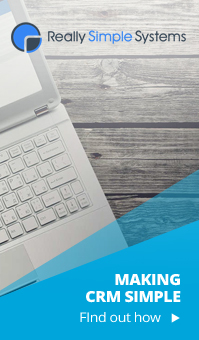
CRM - The Business Case
CRM – Investment Appraisal
CRM systems represent for many businesses and organisations a new type of IT expenditure. While it is still all too clear where costs are to be incurred, the case for the investment cannot necessarily be made in terms of improved efficiencies and therefore reduced costs in existing processes in the organisational value-chain. Obviously, this is not always the case – call centres or internal help-desks may offer significant cost savings over the existing regime. Investment in CRM systems may be a far more risky proposition – with commensurate returns – for example, the survival of the organisation as a viable commercial entity!
If we are investing in a CRM system as a basis for competitive advantage and the winning of new business, the case for the system should be set out as would any investment in plant, equipment or other assets which are intended to generate wealth for the organisation. The costs and benefits need to be defined in tangible terms – not just woolly statements like “improving customer service”, so that management can take a informed view of the inputs and outcomes of the proposed project. In this way, IT investment is not just seen as an expense but an asset for the organisation with all that this entails in maintenance, budgeting and planning etc.
For this article, we have compiled a case study model for an investment in a call-centre. The investment combines elements of improved resource utilisation and a speculative component where the new system will play a part in retaining (and capturing) market share by enabling the delivery of accurate and timely customer service to a growing client base.
We examine the benefits that might accrue to an organisation, the associated costs and finally a comparison. In this way we can determine the value of the investment. It is not just an expense to be pared to the minimum.
a) Benefits
Here we compile all the improvements expected from the implementation of the proposed system.
Certain riders and assumptions need to be stated prior to the presentation of the benefit case:-
- The value of benefits is often arguable, particularly in
case of so-called intangible benefits. However, all underlying assumptions are
stated and any different interpretations of value can be quickly considered.
- The values shown are sales prices - additional sales made as
a benefit of a certain feature. This is not the net benefit as sales have costs
associated. However, it is beyond this analysis to calculate what the marginal
costs are on these additional sales, including all production costs.
- The benefits stated below will not be experienced to the
full extent in the first year, but certainly thereafter, provided that the
customer support system stays in line with customer expectations. This is
clearly an important proviso suggesting that further investment may be required
in subsequent years.
The first table is based on the assumption that the new call centre can offer a performance close to the world best practice benchmark:
- 24hr, 365 days service call availability
- <15 seconds average time to answer the phone
- a technician arrives on any metropolitan site typically
within 1 to 2 hours
- >90% of information / query calls are answered on the
spot
- >90% of returned calls to customers occur within 45
minutes (during business hours)
- All users, from sales and service field staff to senior
executives will have access to all information as defined and permitted by
authorisation levels via password controlled user access.
Note that in the following benefits table, while there are savings to be made by improvements in resource utilisation, these benefits are a mere 9% of the estimated total. The benefits are almost wholly derived from increased business with existing clients and new business. The assumptions that underpin these estimates therefore require rigorous discussion prior to acceptance.
Benefits |
xxxxx |
Additional Revenue & Estimated Savingsxxxxxxxxxxxxxxxxxxxxxxxxxxxxxxxxxxxxxxxxxxxxxxx |
|
(1) With the much improved service response, customers continue to renew service contracts; assume and extra 150 contracts @ AUD45/month |
AUD76,400 |
|
|
(2) Customer satisfaction with support leads to improved sales, increasing market share through new purchases, upgrades and replacements; 100 customers influenced, 5 machines additionally renewed/installed – AUD15,000 average sales price |
AUD7,500,000 |
|
|
(3) New Prospects – expect an increase in market share – 50 new customers, 5 machines each @ AUD15,000 each on average |
AUD3,750,000 |
|
|
(4) Expected productivity improvements increase field service personnel productivity by 10%. Estimated staff reduction. 40 field staff with 10% productivity improvement reduces require by 4 @ AUD100,000 per staff member |
AUD400,000 |
|
|
(5) Improved productivity of client services staff results in 10 effected staff, 10% improvement in productivity @ AUD100,000 costs per staff member |
AUD100,000 |
|
Estimated Total Benefits |
AUD11,826,400 |
In order to isolate the potential benefits of 24hr service coverage the following assumptions have been made, which were included in the numbers on the previous page: -
Benefits |
xxxxx |
Additional Revenue & Estimated Savingsxxxxxxxxxxxxxxxxxxxxxxxxxxxxxxxxxxxxxxxxxxxxxxx |
|
(6)Some customersrequire 24hr availability for support services. This service is mandatory for a number of customer sites; 100 machines under service with AUD45/month service revenue |
AUD54,000 |
|
|
(7)Extended coverageleads to market share improvements 10 new customers per annum, 5 new machines at AUD15,000 |
AUD750,000 |
|
Estimated Benefits from 24hr Coverage |
|
AUD804,000 |
In this case study, there has been some attempt to isolate the benefits associated with each feature specified in the performance benchmark for the call centre. Clearly, this exercise can work both ways:-
- as a basis of estimating the total potential benefits
- to act as a basis for discussion if functionality has to be
reduced due to cost or delivery constraints in the future.
The benefits of a global availability of the call centre are assumed to be as follows:
Benefits |
xxxxx |
Additional Revenue & Estimated Savingsxxxxxxxxxxxxxxxxxxxxxxxxxxxxxxxxxxxxxxxxxxxxxxx |
|
(8)Existing customerswith global resources are happy to contract service in the light of superior service (equivalent to local support anywhere); 500 machines, AUD45/monthly support revenue. |
AUD270,000 |
|
|
(9)Growth in Overseasmarkets is supported by 24hr coverage with access to global resources 100 customers a year influenced, 4 new machines additionally at AUD15,000 |
AUD6,000,000 |
|
Estimated Benefits of Global Connection |
|
AUD6,270,000 |
b) Costs
The cost schedule is an estimate only based on list prices and general estimates of work to build a call centre for about 10 operators, 40 other internal users, about 500 calls during a busy hour and a general design as above in mind.
In terms of 24 hour help desk service, a cost has been built in of an outsourcing service (8pm to 8 am on weekdays, 24 hours on weekends and public holidays at a cost of $65/hour).
Itemizing costs in the manner below enables discrete items to become the focus of cost control throughout the lifetime of the budget. The big picture can be kept in view rather than the “penny wise, pound-foolish” perspective often adopted during IT implementations. In truth, the success of this investment is dependent on the realisation of the estimates of revenue growth rather than the tight control of project costs (which should not, of course, be ignored).
Once only implementation Costs |
xxxxx |
xxxxxxxxxxxxxxxxxxxxxxxxxxxxxxxxxxxxxxxxxxxxxxx |
|
Phone system expansion |
AUD0.00 |
|
|
Operator work stations improvements |
AUD15,000 |
|
|
Central Server expansion |
AUD8,000 |
|
|
Call Server software (40 concurrent users) |
AUD490,000 |
|
|
Implementation of Call Server Software |
AUD350,000 |
|
|
Contract Staff during Cut-Over |
AUD24,000 |
|
|
Training |
AUD38,000 |
|
|
Project Management |
AUD80,000 |
|
|
|
|
|
Total Implementation Cost |
|
AUD1,005,000 |
|
|
|
|
Recurring Costs (per year) |
|
|
|
Additional Maintenance of PABX |
AUD16,000 |
|
|
Additional Maintenance Server Computer |
AUD3,000 |
|
|
Maintenance of Call Centre Software |
AUD72,000 |
|
|
Communications (global access) |
AUD170,000 |
|
|
Additional 1 Staff (operator) |
AUD35,000 |
|
|
After Hour Outsourcing (8pm – 8am) |
AUD340,000 |
|
|
Consultant for reviews/improvements |
AUD12,000 |
|
|
|
|
|
Annual Recurrent Costs |
|
AUD648,000 |
c) Costs/Benefits – Investment Appraisal
In order to make a correct analysis it is important to compare the correct values.
Some benefits are stated in terms of additional sales made as a benefit of a certain feature. This is not the net benefit since sales have costs associated. It is hard to say what the marginal profit of these additional sales is. To complete the analysis a number of assumptions must be made regarding profitability on product and service sales. Again, these assumptions need to be rigorously debated during the investment appraisal as the acceptability of the investment is vitally affected by these assumptions. A word of warning, it is not unusual for an organisation to be unclear on product and customer profitability. The following details are key issues:-
- Additional, marginal sales require little additional
overheads.
- The profitability is assumed to be 30% for additional
marginal sales of the magnitude shown here. That means that 30% of the sales
value is considered the “real benefit” in this analysis.
Other matters for debate include:-
- The taxation ramifications of the investment – how are IT
investments treated – which components of the investment would be considered as
expense, which can be fully depreciated in one or three years.
- Some benefits are stated in terms of increased productivity
of staff, which equates to cost savings - less staff for the same amount of
work or no new hiring for some time until the additional capacity is used up.
- It is assumed that the implementation can be done in about 4
months after which time the operational improvements set in relatively swiftly.
The additional sales benefits will take about another 6 to 9 months to show
results (first with existing customers). In this project, as with all IT
investments it is vital that measurable “value” can be delivered as early as
possible within the project life-cycle so that confidence in the project is
retained by management easily “spooked” by unfamiliarity with the IT
fraternity. The project plan must provide an easily understood “road-map” with
“milestones” clearly indicating progress before “value” is delivered.
- The apportionment and delivery of expected revenue over the
three year period has a crucial bearing on the value of the investment. Are
there any changes to sales processes and promotions that can bring the improved
sales position forward – say from 3rd to 2nd Year
- Our model does not indicate any benefits derived from the
increased cash flow associated with the project, only the increased net
revenue.
- No allowance has been made to understand how key cost
elements might be reduced in the 2nd and 3rd years – in particular
telecommunications, where technology evolution and competition is reducing
costs considerably
- No allowance appears to have been made for any functional
enhancements or additional software components. Equally all the software costs
appear to be taken up in the first year of the project. Is this necessary –
could the cost of the software have been spread over the three years of the
project.
Note:
Years are 12 months periods without any connection to a calendar or financial year. Year 1 has started mid February including the current Design and Business Case development phase. The cost of the current phase is included.
Date posted: 2014-12-23 | posted by: miked
Tweet



